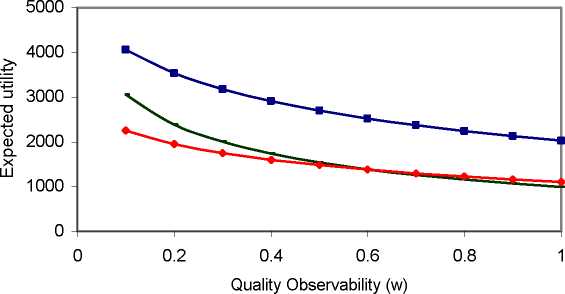28
and interpreting policies on mergers more leniently for the food industry. Our results suggest
that market concentration and/or identification of firms producing a given unit of output may
result in higher overall welfare.

-----Reputation is a public good
• Monopoly
—■— Reputation is a private good
Figure 4. Equilibrium expected utility for the three scenarios considered for different
levels of quality observability (a = 50, b = 1, β= 0.9)
Conclusions
There exists a great disparity in existing QASs concerning the degree of stringency (and
associated costs) of the systems employed. We provide a rationale for those differences based
on market structure, the nature of the reputation mechanisms, and the size of the markets or
strength in demand for value-added products and whether the sought-after attributes are
credence, experience, or a mixture of both. We argue that QASs can be seen as efforts made by
firms to position themselves strategically in a marketplace where consumers can differentiate
between firms that deliver quality goods and those that deliver substandard quality.
Three models are developed to accommodate the different scenarios (monopoly,
duopoly with collective reputations, and duopoly with private reputations), and predictions are
obtained through comparative statics and numerical simulations. The later are performed under
the widely used assumptions of linear demands and constant marginal costs.
More intriguing information
1. Economie de l’entrepreneur faits et théories (The economics of entrepreneur facts and theories)2. Flatliners: Ideology and Rational Learning in the Diffusion of the Flat Tax
3. Orientation discrimination in WS 2
4. The name is absent
5. The name is absent
6. Developing vocational practice in the jewelry sector through the incubation of a new ‘project-object’
7. Urban Green Space Policies: Performance and Success Conditions in European Cities
8. Has Competition in the Japanese Banking Sector Improved?
9. Evolution of cognitive function via redeployment of brain areas
10. Eigentumsrechtliche Dezentralisierung und institutioneller Wettbewerb